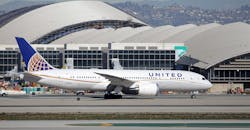FAA Investigating Boeing 787 Structural Defects
Structural problems discovered on some Boeing 787 Dreamliner aircraft and reported last month now have led now the Federal Aviation Administration to conduct a historical review of quality-control issues at the North Charleston, S.C., assembly operation, according to a Wall Street Journal source.
Further, Boeing has slowed deliveries of the wide-body 787, as it inspects more recently completed aircraft for signs of those and other production flaws.
Boeing acknowledged to the Seattle Times that a new defect has been uncovered on the 787's horizontal stabilizer, as a result of some components being clamped together with excess force during assembly, which may leave the structure with wider than acceptable gaps between components. This problem is traced not to the South Carolina assembly plant but to a plant Salt Lake City where Boeing fabricates the 787 tail assembly.
A Boeing spokesperson explained in the newspaper report that the required "gap tolerance" is about four-thousandths of an inch, and that these gaps typically are filled with composite shims.
Boeing identified the stabilizer flaw in February of this year during an internal audit and concluded that it may lead to premature aging of the horizontal tail structure.
The Boeing representative said this problem is believed to affect 893 (of a total 982) 787s already in service with airlines, but that it is not an immediate safety concern because none of those jets are within a window of service time when they would experience the type of aging resulting from the manufacturing issue. Boeing is correcting the issue on airplanes that have not yet been delivered.
In August Boeing Co. grounded eight 787 Dreamliner aircraft for inspection and repair of two structural flaws related to the jets' manufacturing and assembly.
The first defect was first discovered in August 2019 and involves the joint for two composite-material sections at the rear of the 787 fuselage, which were welded together at the South Carolina complex. The problem concerns "shims" that are custom-formed by the robotic welding system to fill any gaps where two, barrel-shaped sections are joined — to avoid any structural weaknesses. Some of these gaps were improperly filled.
A second error was discovered last month and concerns the inner surface of the fuselage at the joint that was insufficiently smooth to ensure a reliable joint. The two flaws in combination could create out-of-tolerance gaps at that fuselage joint, according to Boeing.
The eight aircraft identified for inspection and repair of that combination of problems include individual jets operated by Air Canada, Singapore Airlines, and United Airlines.
